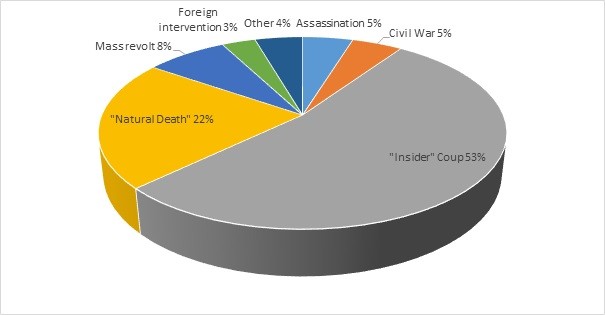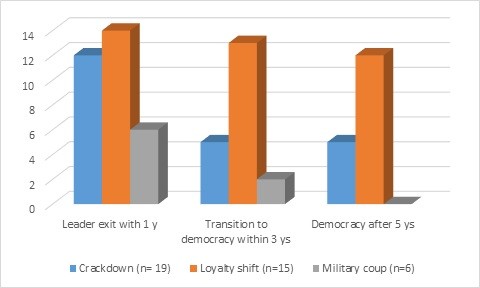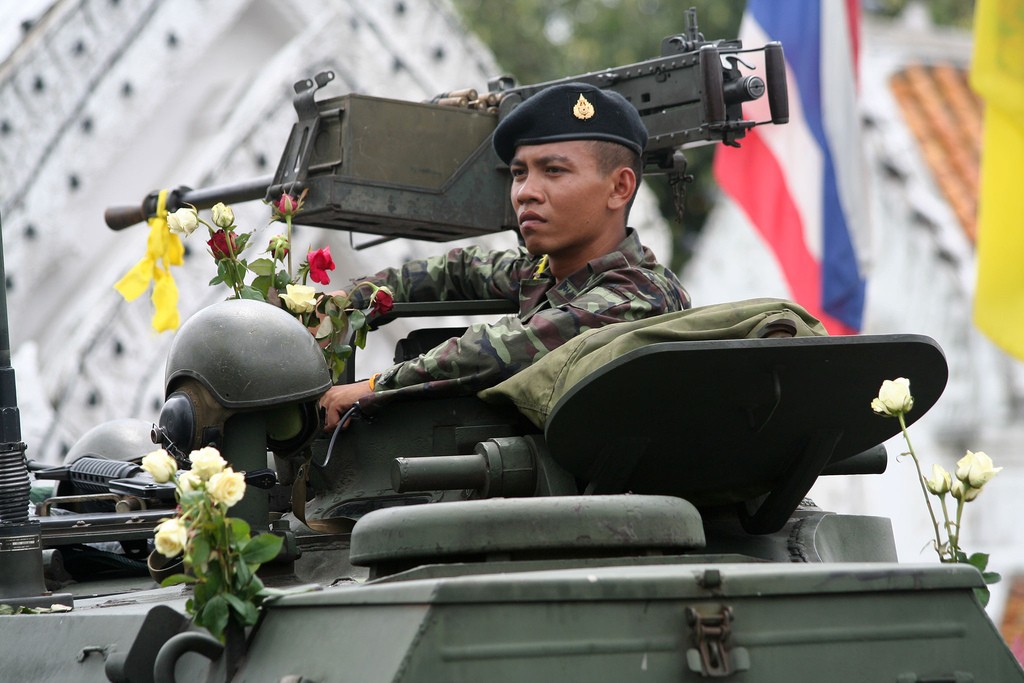Militaries Hold the Key to Power in a Dictator’s Endgame
Which factors shape the armed forces’ decision to boost or bust the rule of an incumbent autocrat in times of political turmoil? Political scientists at Heidelberg University analyzed non-violent mass mobilizations since 1946 and developed a game theory model that aims to explain the different military responses.
Autocrats live dangerously. Although their average tenure is higher than that of democratically elected leaders, the risk is much greater that they will be swept out of office in an “irregular” way – usually by a coup d’état. According to Milan Svolik’s Leadership Change in Dictatorships data set, of the 663 authoritarian leaders who exited office in the period 1946 to 2008, 259 (41%) lost power because of term limit, voluntary resignation, lost elections or because their term was interim. The remaining 404 autocrats were deposed by a coup, forced out of office by mass protests or uprising, because of foreign intervention or interstate war, left office due to a civil war, or were assassinated.

The loss of office itself is also dangerous for autocrats, as a glance at the Archigos Database suggests. In terms of post-tenure fates for dictators, almost half of them were imprisoned, executed or assassinated or fled their countries after losing office during the period 1946 to 2012.
Historically speaking, the most frequent threat to an autocrat’s rule comes from regime insiders. The military coup d’état is the most common form of insider deposal by coup, but there are other elite-led conspiracies that involve the threat or use of force. For example, the Emir of Qatar, Sheikh Khalifa bin Hamad al-Thani, was deposed by his own son, Crown Prince Sheikh Hamad bin Khalifa al-Thani, in a bloodless palace coup in June 1995. In contrast, mass protests and mass revolts have rarely forced autocrats from power.
However, in the past three decades a very different picture has emerged, as the relative predominance of leader exits precipitated by the masses has sharply increased in the last three decades. With the rise of “nonviolent revolutions”, “people power movements”, “democratic revolutions”, “color revolutions”, and “unarmed insurrections”, many studies have attempted to analyze the origins and outcomes of anti-incumbent mass-protests demanding regime change but not necessarily achieving it. While explanations differ, there is one common finding: the ability of an autocrat to keep his military loyal is a key factor for the outcome of the revolt. However, when regime leaders attempt to lean on their armed forces of support for survival, they often find that military leaders refuse to obey such orders. Furthermore, not only do militaries’ responses vary widely – the outcomes of nonviolent anti-incumbent mass show also a great deal of variation protest in terms of actual leader and regime changes. This is shown in the recent regime crises in the Middle East and North Africa but even before the Arab Spring there were dozens of episodes of popular uprisings in different countries and regions worldwide, whose success or failure was contingent upon the loyalty of troops.
Yet, if military loyalty plays such a critical role, and since the manner in which autocrats exit office affects the political trajectories of countries once the autocrat has been deposed, what explains whether military leaders attempt to defend a dictator from mass mobilization, or, in contrast, openly flout political orders? How to explain the differences between military defection by organizing a coup d’état, shifting loyalty to the opposition side or staying quartered?
With some fellow political scientists, I examine these questions in a current research project at Heidelberg University. We argue that although the existing scholarship identifies many different individual factors and partial explanations, the determinants and underlying causal mechanisms of the military’s roles in anti-incumbent mass uprisings are still poorly understood, mainly for two reasons. First, the literature suffers from a lack of conceptual clarity. Instead, it addresses a wide spectrum of different phenomena that ranges from government crisis to military coups, revolutions, and civil wars, and that conflate violent and non-violent forms of mass protest. Second, we still are lacking a coherent theoretical model that is amenable for systematic empirical evaluation across a wide range of different societies and outcomes.
Our research offers what we believe to be the first global investigation of military responses to what we conceptualize as the “dictator’s endgame” – i.e., situations of primarily non-violent mass mobilization, in which the dictator’s political survival depends on the loyalty of the military leaders and their willingness to disperse protests. It seeks to account for the full range of different military responses, from crackdown on protests, loyalty shifts either by “staying quartered” in the barracks (i.e. East Germany) or joining the opposition (i.e. Romania and Tunisia), to military attempts to unseat the dictator and to take over the government, at least temporarily (“coup”). We broaden the timeframe (1946-2014) to examine the universe of “endgames” as the whole. At the same time, we set the scope conditions to exclude mass protests in democracies as well as armed insurrections. There are two reasons for this. First, we focus on authoritarian regimes because dictatorships, in contrast to democracies, “inherently lack an independent authority with the power to enforce agreements among key political actors, and violence is never off the table.” (Svolik 2012, 196). We determined the regime type by drawing from democracy data from Polity IV and the Bertelsmann Transformation Index. Second, we focus on instances of predominately non-violent mass mobilization because existing studies demonstrate that there is a systematic difference in military reactions to mass protest depending on whether the opposition applies tactics of armed struggle (to which the military usually responds with repression) or if it primarily employs civil campaign techniques.
Overall, we have identified and examined forty episodes of dictator’s endgames in Latin America, South and Eastern Europe, Asia, Africa and the Middle East and North Africa in the period 1946 to 2014. While not a historically new phenomenon, most endgames (32) took place after 1980, of which twelve happened in the period 1982-1989, eight from 1990 to 1998, and twelve since 2000. Furthermore, while we find endgames in all regions of the world except North America, South Pacific and Northwest Europe, they are particularly frequent in East and South Asia (13), (post)communist Europe (including CIS) (8), and the Middle East and North Africa (10), although the latter is primarily due to the Arab Awakening since 2010.
About military responses, we find that military crackdown on protests is the most frequent reaction (19), followed by loyalty shifts (15) and military coup d’état (6). Loyalty shifts usually lead to leader exit within one year. The only exception is Madagascar (1991) but here, President Didier Ratsiraka conceded to the protesters’ demands in October 1991, and lost the presidential election in February 1993 to Forces Vives candidate, Albert Zafy.

Yet, crackdown is no guarantee for a secure tenure for the autocrat. In 12 of the 19 cases in which military leaders decided to suppress the protest movement, leaders were nevertheless deposed from office, mostly because of pressure from inside the regime coalition and shifting patterns of political allegiance and power. While loyalty shifts have a good record in producing transitions to democracy within three years (only exceptions are Albania 1990-1994 and Kyrgyzstan 2005-2008), crackdown despite leader exit often do not initiate transitions to democracy, and military coups during anti-incumbent mass protests also rarely lead to transitions to democracy within the first three years following the endgame. Egypt’s development since the 2011 popular uprising is a typical example. A case like Pakistan under President Zia ul-Haq, where military repression prevented regime (or leader) change in the short run but might have contributed to the transition to democracy at a later point in time, after the autocrat died in a helicopter crash, is an exception.
These findings call for explanations. We develop a game theoretical model that aims to explain the different military responses. In doing so, we argue that dictators are brought down by their own failure to spoil their armed forces with an adequate share of economic prerogatives and political concessions. Even though military reactions to mass mobilizations are shaped by a complex concurrence of different factors, the dictator’s survival ultimately hinges on his ability to present the option of staying loyal and cracking down on demonstrators as the most profitable choice to the military. Whether they are able to do so depends, we argue, mainly on the combination of four causal conditions. First, the strategies the autocrat uses to maintain his control over the armed forces. Second, the social diversity and broadness of the protest movement; third the extent to which military leaders are involved in human rights violations prior to the “endgame”; and, fourth, the extent to which the cohesion of the military is undermined by factionalism and vertical or horizontal intra-military conflicts.
Yet, these explanations are preliminary, need further empirical tests (including in-depth case studies and statistical or qualitative-comparative analyses) and constitute only the first step in the development of empirically robust inferences. First, as of now our model is limited to the strategic interactions between the dictator and the military leadership, treating the activities of the opposition and the size of the outside option as model-exogenous. We are working on extending the game theoretical model to include strategic interactions between the military and the opposition. Second, while case studies corroborate the expectations derived from our model, we need to test it against additional empirical data. Finally, in order to make the argument as parsimonious and coherent as possible, we deliberately limited ourselves to a domestic and rationalist perspective. Consequently, we will test our theory against alternative, international and ideational explanations.
Aurel Croissant is Chair Professor of Political Science at Heidelberg University, Germany. He is Regional Coordinator for Asia and Oceania in the Bertelsmann Stiftung’s Transformation Index (BTI).

